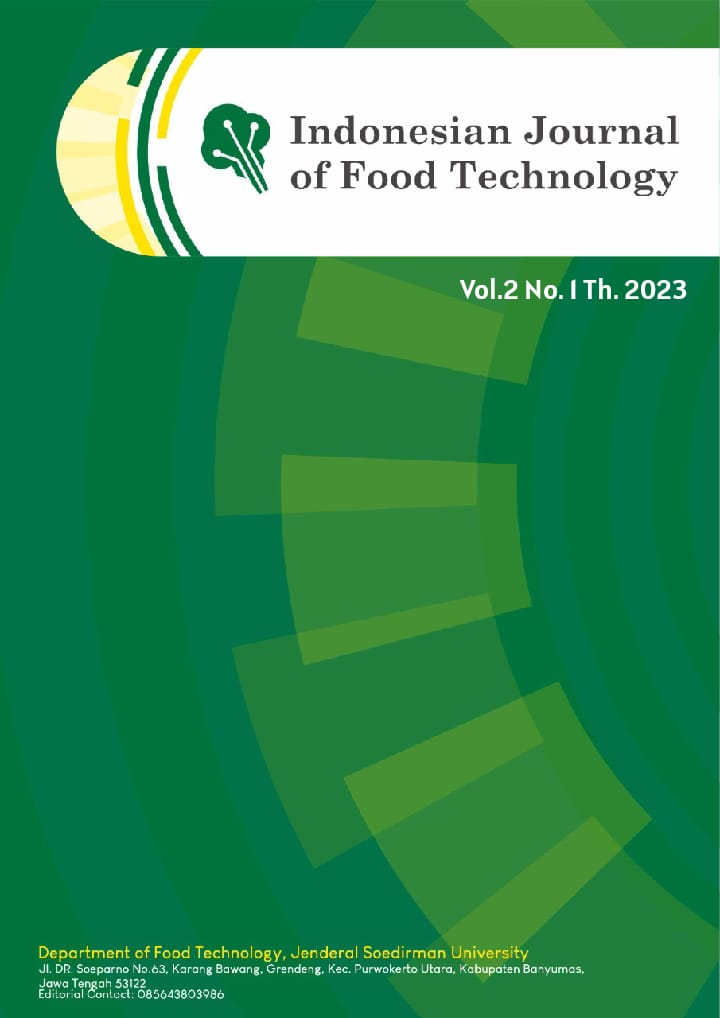Physicochemical and Sensory Characteristics of Black Grass Jelly Drink on Variations in Type and Concentration of Hydrocolloids
Abstract
Sokawera Village is a village located in Cilongok District, Banyumas Regency, Central Java Province. The village has one of the most abundant agricultural commodities, namely black grass jelly. There are many black grass jelly plants and there is enough potential to be developed in the village. This study aims to determine the physicochemical and sensory characteristics of black grass jelly drink which is influenced by the type of hydrocolloid and the hydrocolloid concentration, and to determine the combination of type and concentration of hydrocolloid which produces the best physicochemical and sensory characteristics of black grass jelly drink. This study used a factorial Completely Randomized Design method with two factors, namely the type of hydrocolloid (J) which consisted of 2 levels (carrageenan and jelly powder) and the concentration of hydrocolloid (K) which consisted of 4 levels (0.4; 0.5;0,6; & 0,7%). The test variables for physicochemical characteristics include viscosity, pH, water activity (Aw), syneresis, ash content, and water content, as well as testing for sensory properties including color, aroma, taste, texture, and overall preference. The test results of physicochemical and sensory variables were analyzed using analysis of variance and DMRT at the level of = 5%. The results showed that the type of carrageenan hydrocolloid produced a jelly drink of black grass jelly with a lower viscosity and higher syneresis than the type of jelly powder hydrocolloid. Hydrocolloid concentration of 0.7% produced better physicochemical and sensory characteristics of black grass jelly drink than hydrocolloid concentration of 0.4; 0.5; and 0.6%. The best treatment in this study was obtained in the combination of 0.7carrageenan treatment (J1K4).
References
Herawati, H. 2018. Potensi Hidrokoloid Sebagai Bahan Tambahan pada Produk Pangan dan Nonpangan Bermutu. Jurnal Litbang Pertanian, 37(1) : 17-25.
Hermawan, J., D. 2020. Pengaruh Konsentrasi Karagenan Terhadap Sifat Fisikokimia dan Sensori Jelly Drink Cincau ( Cyclea barbata). Skripsi. Fakultas Teknologi Pertanian, Universitas Semarang, Semarang.
Jariyah, Rosida, Defri, I., & Wardani, P. E. K. (2022). The Physicochemical Properties of the Jelly Drink Produced by Mixing Pedada (Sonneratia caseolaris) and Young Coconut Juices with Carrageenan. MATEC Web of Conferences, 372, 02006. https://doi.org/10.1051/matecconf/202237202006
Pamuji, M. W. 2014. Pengembangan Bionanokomposit Film Berbasis PAti Tapioka dan Nanopartikel ZnO dengan Plasticizer Gliserol. Skripsi. Fakultas Teknologi Pertanian, Institut Pertanian Bogor, Bogor.
Permana, T., Ramaputra, J., & Santoso, F. (2020). Product development of low sugar ready-to-drink (RTD) soy jelly drink. Journal of Functional Food and Nutraceutical, 2(1), 43–52. https://doi.org/10.33555/jffn.v2i1.41
Rittisak, S., Lonuch, N., Buakeeree, S., & Yimtoe, S. (2023). Development of jelly drink from cultivated banana pseudo stem juice (Musa sapientum L.) and pineapple juice supplemented with pineapple pulp. Food Research, 7(2), 52–59. https://doi.org/10.26656/fr.2017.7(2).721
Rujito, H., Utami, M. M. D., Riskiawan, H. Y., Hermanuadi, D., & Retnowati, N. (2020). Product design of kolang kaling grass jelly drink through the application of quality function deployment method (case study in meru betiri national park, banyuwangi district). IOP Conference Series: Earth and Environmental Science, 411(1), 12024. https://doi.org/10.1088/1755-1315/411/1/012024
Sari, V. M., Haryati, S., & Putri, A. S. 2018. Variasi Konsentrasi Karagenan pada Pembuatan Jelly Drink Mangga Pakel (Mangifera foetida) Terhadap Sifat Fisikokimia dan Uji Organoleptik. Laporan Penelitian. Fakultas Teknologi Pertanian, Universitas Semarang, Semarang.
Selviana, S. 2016. Pengaruh Konsentrasi Karagenan dan Gula Pasir Terhadap Karakteristik Minuman Jelly Black Mulberry (Morus nigra L.). Skripsi. Fakultas Teknik, Universitas Pasundan, Bandung
Sukotjo, S., Irianto, H., Leonita, S., & Sari, N. Y. (2022). The Effects of Tomato Concentration on Sensory and Chemical Properties of Jelly Drink. Proceedings of the 6th International Conference of Food, Agriculture, and Natural Resource (IC-FANRES 2021), 16, 184–189. https://doi.org/10.2991/absr.k.220101.024
Tasia W., R., N., & Widyaningsih, T., D. 2014. Potensi Cincau Hitam (Mesona palustris BI.), Daun Pandan (Pandanus amaryllifolius) dan Kayu Manis (Cinnamomum burmannii) Sebagai Bahan Baku Minuman Herbal Fungsional. Jurnal Pangan dan Agroindustri, 2(4) : 128 -136.
Wibowo, A. 2009. Studi Pembuatan Jelly Drink Sari Bunga Rosella(Hibiscus sabdariffa L.) Tinjauan Proporsi Tepung Porang dan Karagenanserta Penambahan Sukrosa. Skripsi. Jurusan Teknologi Pertanian, Fakultas Teknologi Pertanian, Universitas Brawijaya, Malang.
Widjaja, W. P., Sumartini, & Rifani. 2017. Pengaruh Konsentrasi Jelly Powder Terhadap Karakteristik Minuman Jeli Ikan Lele (Clarias sp.). Pasundan Food Technology Journal, 4(3) : 197-207.
Widyaningsih, T. D., & Safitri, R. M. 2014. Efek Antidiare Minuman Fungsional Jelly Drink Cincau Hitam ( Mesona palustris BL). Jurnal Agroteknologi, 8(01) : 74-84.











